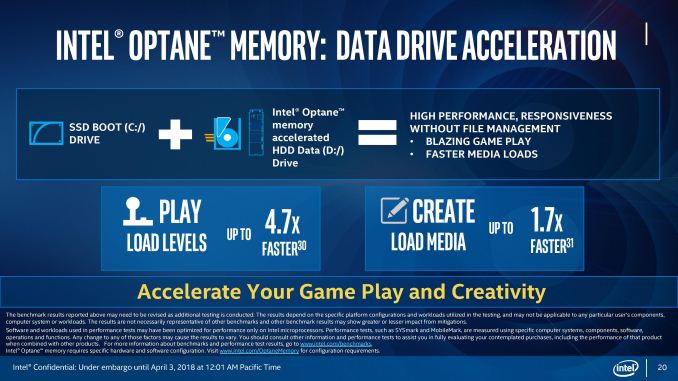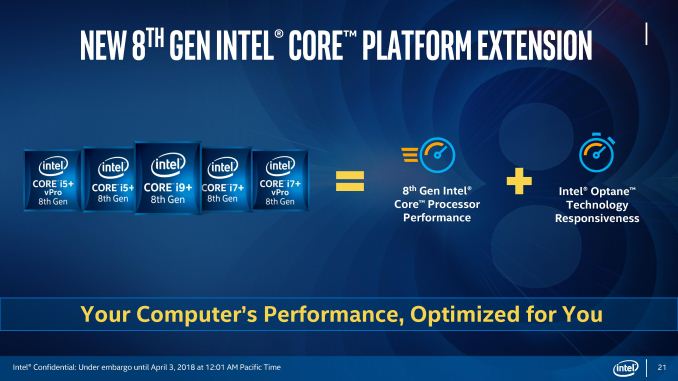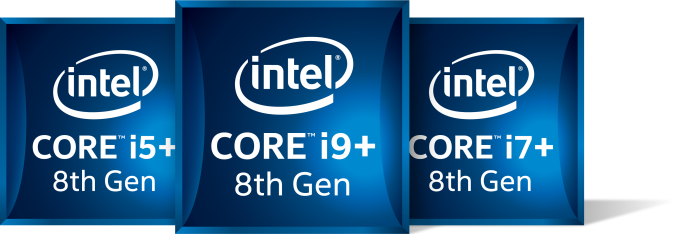Intel Expands 8th Gen Core: Core i9 on Mobile, Iris Plus, Desktop, Chipsets, and vPro
by Ian Cutress on April 3, 2018 3:01 AM ESTNew Optane Branding
Core i9+, Core i7+, Core i5+
One of the items that Intel is keen to promote with this launch is an update to its Intel RST algorithm when dealing with ‘Optane Memory’, Intel’s brand for Optane whereby a small amount of storage is placed in front of a larger drive to act as a fast cache. Up to this point, Intel platforms that supported Optane Memory in this configuration could only do so on the drive that was used to boot into the operating system. While this worked well for low-cost users that relied on a single rotational hard-disk drive of rust for their needs, with most enthusiasts using a fast SSD (SATA or PCIe) as their first drive that loads the OS, putting Optane Memory in front of this as a cache was relatively pointless – any gains would be intangible at best. With the new generation of products, Intel has expanded the capabilities of Optane Memory such that it can act as a cache for a non-OS drive. This means that a user can have a fast SSD boot drive, a large spinning drive for storage, and then place Optane in front of that storage drive to potentially get much better performance from the drive.
The main idea here is that the large rotational drive is where users store games and large files used in content creation, which often have a long loading time. With the right caching algorithm, and a decent sized Optane Memory drive, Intel likes to promote that loading games and loading media for creative purposes are several factors faster than an equivalent system without an Optane Memory drive.
Part of the news around Optane is that Intel is now creating new processor branding for OEMs that have configurations with Optane. The new brands and logos are similar to the standard Core i5/i7 style that we are used to, however the logos are now a dark blue with white text, and exhibit a plus after the Core i5/i7 name.
So just to be clear, this is not a new line of processors. We will not have to suddenly deal with a Core i9+-8950HK being different to the non-plus counterpart. This is purely a branding exercise, and one that only covers the i5 and higher at that. However, to complicate things, this means that specification sheets can (and will) list the processors as Core i5+ and Core i7+ and even vPro models. This makes looking for particular processor versions in search engines a lot more difficult for almost no obvious benefit. I mean sure, Intel wants to promote the use of its Optane drives, but we already have the Optane branding and the Optane logos to do that for us. This ends up being another logo put onto the box.
Ultimately, Intel is still marketing Optane, its high-cost R&D product, with low capacities at low cost systems with relatively little margin. While it might seem like a noble goal, to bring extra caching performance down to the lower cost segment, it could very easily be done with SATA or PCIe M.2 drives using regular NAND flash. A lot of users would like to see high-capacity, high-endurance Optane drives moving more into the mainstream, instead of more attempts at funneling in a product like Optane into caching.













123 Comments
View All Comments
HStewart - Saturday, April 7, 2018 - link
"It took a few years before big programs like Photoshop had native Mac Intel ports."Wrong... Photoshop originally was created on Mac and later ported to Windows.
https://en.wikipedia.org/wiki/Adobe_Photoshop#Earl...
ARM MacBook would have many challenges - it would also have to be able to run Windows programs and more importantly able to recompile applications for OS on the same machine.
Apple has rumors of attempting an ARM based Mac - but so far ARM is using in display controllers for 5K screens and in iOS products. Apples wants people to believe that iPad Pro's are PC replacements - but they no more that glorified iPad's. The new iPad is good example of this and has same Apple Pencil and probably faster that original iPad Pro.
serendip - Sunday, April 8, 2018 - link
I remember using Photoshop on the first Intel Macbook in 2006, it was translated from PowerPC code using Rosetta. This was in OS X, not Windows. The OS X Intel (Universal) port arrived two years later. The translated version was surprisingly bearable to use on a Macbook even when compared to the PowerPC native port running on a top-spec G4 Powerbook.Rosetta saved the translated code so it wouldn't be so slow on subsequent running. Apple could do the same thing to get OS X Intel code working on an ARM Macbook, just like what Qualcomm and Microsoft are doing on Windows Snapdragon PCs.
As for coding, Xcode has iOS ARM targets so adding a MacOS ARM variant shouldn't be difficult. I'm not sure about Windows on ARM Macbooks though. Apple might be willing to drive away that user segment because it's so small and niche.
FunBunny2 - Tuesday, April 3, 2018 - link
"A non Intel based Mac will never replace high end mac"again. they've been on 3 processors so far.
HStewart - Saturday, April 7, 2018 - link
I believe Apple makes it's announcements in June They would be foolish not to release the 6 core mobile MacBook Pro update - they would not wanted to compete with new Windows notebooks using 6 cores.On the Apple move for own CPU, I think it only going release in low end Mac line if so - possible in the iOS line. Apple has always blindly want people to believe iPad Pro are desktop replacements - but until those devices can actually successfully run the Mac development tools that allow developers to create iOS applications, Apple is dream - in any ask espected processing power is expected to be very limited.
Another big concern that Mac line has to live with Windows compatibily - Mac are good for limited purpose - which Apple has been very good at - primary in schools - but also in graphics industry but that is no longer the case. There are other options - especially in schools.
Tyler_Durden_83 - Tuesday, April 3, 2018 - link
Which sku do you think will power the next nucs (the normal ones, not the gaming oriented hades canyon ofc).TheBestPessimist - Tuesday, April 3, 2018 - link
+1 i'd love to know that as well.abrowne1993 - Tuesday, April 3, 2018 - link
I don't understand the designation of certain chips as i3, i5, i7, i9 on mobile recently. At least on desktop you can immediately identify how many cores and threads they have (outside of HEDT). It seems so arbitrary on mobile now.DanNeely - Tuesday, April 3, 2018 - link
It's always been a lot more arbitrary on mobile with significant spec differences at each branding level depending on the TDP.edzieba - Tuesday, April 3, 2018 - link
Absence of Z390 is interesting, many were expecting that alongside the H/Q/B PCHs.FunBunny2 - Tuesday, April 3, 2018 - link
they really ought to come up with a different name. this one is a mashup of ancient IBM Big Iron. not, I'd wager, the image they seek.